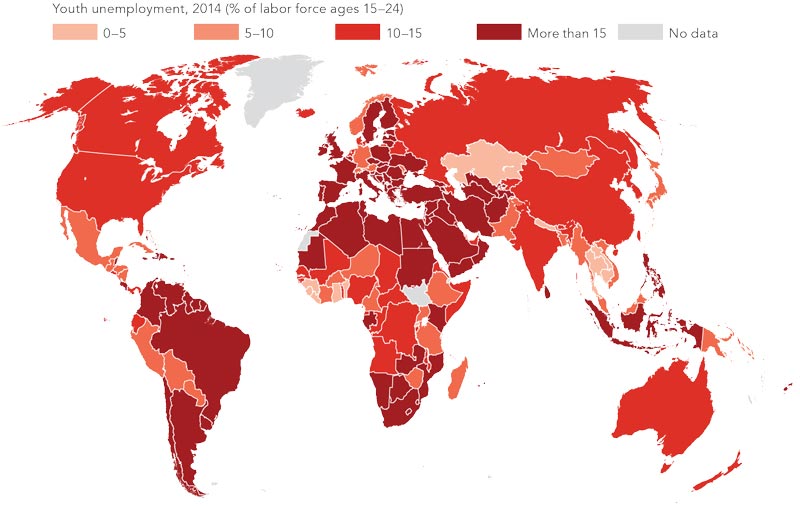What you are about to read:
In the world of forex trading, economic indicators play a crucial role in shaping market sentiment and price movements. One of these fundamental indicators that holds significant importance is the unemployment rate. Understanding the dynamics of unemployment rate data in forex and its impact on forex markets is essential for traders seeking informed decision-making and effective navigation of market fluctuations. Stay tuned with this brokerland article to learn forex trading and become familiar with this highly important concept.
Unemployment Rate in Forex
The unemployment rate in forex, much like the inflation rate or interest rate, is a key economic indicator that measures the percentage of the total workforce that is unemployed and actively seeking employment in an economy. Whether trading is your primary activity or you prefer part-time trading, knowing this rate and its effects on the market is crucial.
The unemployment rate acts as an economic health barometer reflecting the labor market situation and overall economic conditions. Governments and central banks meticulously monitor this rate as part of their efforts to assess labor market performance and formulate appropriate monetary and fiscal policies.
How is the Unemployment Rate Calculated?
The unemployment rate is typically calculated by dividing the number of unemployed individuals by the total labor force (including both employed and actively unemployed individuals) and multiplying by 100 to express it as a percentage. The formula is as follows:
Unemployment Rate = (Number of unemployed / Total labor force) x 100
Governments gather unemployment-related data through various methods, including household surveys, establishment surveys, and unemployment insurance claims. The frequency of data publication varies across different countries, with some reporting monthly figures and others reporting quarterly or annually.
Importance of Unemployment Rate in Forex
The unemployment rate in forex serves as a leading indicator of economic performance and can have a significant impact on forex markets for several reasons:
- Economic Health: A high unemployment rate often indicates an economy struggling with weak consumer spending, reduced business investment, and sluggish economic growth. Conversely, a low rate signals a robust economy with ample job opportunities and strong consumer confidence. Forex traders closely monitor changes in this rate from credible sources such as Forex Factory, government websites, or economic calendars tracked on platforms like TradingView along with some social trading websites to gauge the overall health of an economy and adjust their trading strategies accordingly.
- Central Bank Policy: Central banks carefully examine labor market data, including the unemployment rate, as part of their duties to maintain price stability and promote maximum employment. Changes in this rate can influence central bank monetary policy decisions such as interest rate adjustments and quantitative easing programs. Forex traders pay close attention to central bank statements and monetary policy meetings as changes in policy direction can impact currency values and market sentiment, which we discussed in sentiment analysis.
- Interest Rates: The relationship between the unemployment rate and interest rates is a key consideration for forex traders. Central banks often use interest rate policies to stimulate or dampen economic activity in response to changes in the unemployment rate. For example, if unemployment is rising, a central bank might lower interest rates to encourage borrowing and spending, thereby stimulating economic growth. Conversely, if unemployment is low and inflationary pressures are rising, a central bank might raise interest rates to maintain price stability. Changes in interest rates can impact currency values and stimulate forex market fluctuations.
- Market Sentiment: The release of this rate is a highly anticipated event in the forex market because it provides valuable insight into the economic situation and future monetary policy actions for traders. Positive surprises, such as lower-than-expected unemployment, can boost investor confidence and strengthen bullish sentiments towards a currency.
Conversely, negative surprises, such as higher-than-expected unemployment, can trigger risk aversion and lead to a depreciation of the currency. Forex traders carefully analyze the data of this rate in relation to other economic indicators to create a comprehensive view of market sentiments and potential opportunities.
Strategies and Considerations when Trading with this Rate
When trading with the unemployment rate in forex, it’s essential for a forex trader to employ a comprehensive approach that considers various factors and market dynamics. Here are some strategies and considerations to keep in mind:
Economic Calendar: Stay informed about future economic news and events by regularly reviewing the economic calendar to anticipate the formation of kill zones and even analyzing and identifying order blocks. This rate is usually scheduled for release on specific dates as part of government or central bank data announcements. Plan your trading strategy accordingly and be prepared for potential market fluctuations surrounding the release of unemployment data.
Fundamental Analysis: Incorporate unemployment rate data into your fundamental analysis framework to evaluate the overall health of an economy and its implications for currency valuation. Consider how changes in this rate may impact central bank policy decisions, interest rates, and market sentiments. Analyze past unemployment data trends and currency correlations to identify potential trading opportunities.
Technical Analysis: Combine unemployment rate data with technical analysis tools and indicators to identify key support and resistance levels, trend line patterns, and entry/exit points. Monitor price action around the time of rate releases for potential breakout or reversal opportunities. Use technical analysis to validate your fundamental analysis and enhance your trading decisions.
Risk Management: Implement proper risk management techniques to protect your capital and minimize potential losses when trading with this rate. Set stop-loss orders, define risk to reward ratios, and avoid excessive leverage. Be prepared for market volatility and unexpected price fluctuations following the release of unemployment data. If market conditions become too unpredictable, reduce your position size or stay on the sidelines.
Stay Adaptive: Stay flexible and adaptable in your trading approach with changing market conditions. Be prepared to adjust your strategy based on new information, changes in economic data, and shifts in market sentiments. Stay aligned with geopolitical developments, global macroeconomic trends, and other external factors that may impact forex markets alongside this rate.
Comparing Unemployment Across Different Countries
Let’s compare the unemployment rates of several countries as the latest available data. Please note that this rate can fluctuate over time due to various economic factors, so referring to the latest data for accurate comparison is essential. Here, we’ll look at unemployment in the United States, Germany, Japan, and Brazil:
Unemployment Rate in the United States
Based on the latest available data, the unemployment rate in the United States is approximately 3.9%. The US labor market has experienced significant fluctuations in unemployment due to the COVID-19 pandemic, with rates rising in early 2020 before gradually declining as economic recovery efforts took hold. The Federal Reserve closely monitors unemployment data as part of its dual mandate to achieve maximum employment and stable prices.
Germany
Germany, as the largest economy in the Eurozone, enjoys relatively low unemployment rates compared to many other developed countries. According to the latest data, this rate in Germany is approximately 3.5%. Germany’s strong industrial sector, robust export performance, and emphasis on vocational training contribute to its relatively low rate.
Unemployment Rate in Japan
Japan’s unemployment rate has historically been lower than many other developed countries, partly due to unique demographic challenges and the dynamics of its labor market. According to the latest data, this rate in Japan is around 2.8%. However, Japan faces long-term structural issues such as an aging population and limited labor force participation among specific demographic groups, which could pose challenges to maintaining low rates in the future.
Brazil
Brazil, as one of the largest economies in Latin America, has relatively high unemployment rates compared to many developed countries. According to the latest data, this rate in Brazil is approximately 11.2%. Economic fluctuations, political uncertainties, and structural issues contribute to Brazil’s persistent unemployment challenges. The Brazilian government has implemented various political measures to stimulate job creation and reduce unemployment, albeit with gradual progress.
By comparing these unemployment rates, significant variations can be observed among countries due to differences in economic structures, policy frameworks, and demographic factors. While some countries maintain relatively low rates due to strong economic fundamentals and effective labor market policies, others face ongoing challenges in achieving and sustaining full employment.
Forex traders should consider these changes in unemployment rates alongside other economic indicators when analyzing currency pairs and formulating trading strategies. Additionally, geopolitical events, central bank decisions, and global economic trends can also influence these rates and currency values, underscoring the importance of awareness and adaptability in Forex trading.
Summary
In summary, unemployment rates in Forex are a vital economic indicator that carries significant importance in trading, as discussed in this article by Brokerland. As a reflection of labor market conditions and overall economic health, changes in this rate can impact currency values, central bank policies, and market sentiments. By understanding the dynamics of unemployment and its impact on Forex markets, traders can make informed decisions and effectively navigate market fluctuations.
Incorporate unemployment rate data into your trading strategy, conduct thorough analysis, and use proper risk management techniques to enhance your trading performance in the dynamic world of Forex. There are numerous resources available for monitoring these rates, and sometimes Forex IB websites provide information on such economic indicators, including the Dollar Index, to traders.











